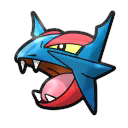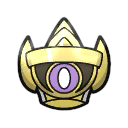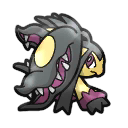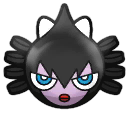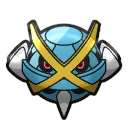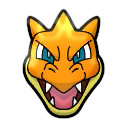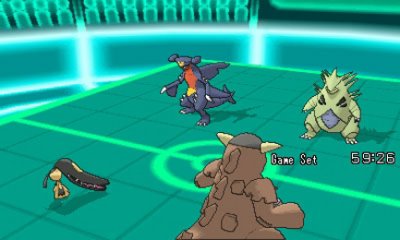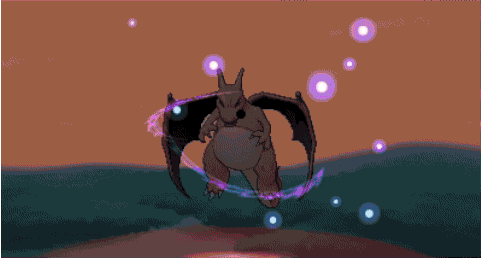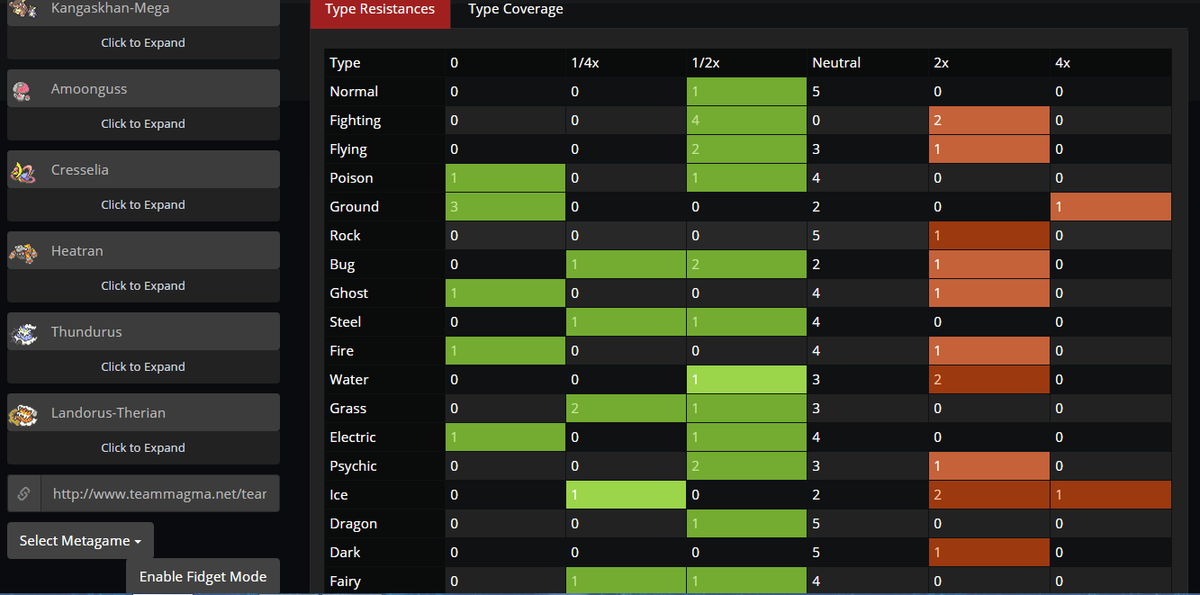List of VGC and Battle Spot Doubles Cores (2015-2016): Part 2
- Pokémon featured: Mega Gengar and Whimsicott
- Metagame: Battle Spot Doubles (VGC 15)
- Core Type: Hyper Offensive
- Sets:
Gengar @ Gengarite
Ability: Shadow Tag
EVs: 4 HP / 252 SpA / 252 Spe
Timid Nature
- Shadow Ball
- Sludge Bomb
- Disable
- Protect
Whimsicott @ Focus Sash
Ability: Prankster
EVs: 252 HP / 4 SpA / 252 Spe
Timid Nature
- Taunt
- Encore
- Tailwind
- Moonblast / Giga Drain
Introducing the infamous Prankster Encore / Disable core of Mega Gengar and its partner in crime Whimsicott. To begin, once Gengar Mega Evolves into Mega Gengar, it gains the ability Shadow Tag, which prevents all Pokemon aside Ghost-types from escaping via switch. With Mega Gengar's insane base 170 Special Attack stat, the opponent have to choose whether to takeconsiderable damage from one of its STABs, or possible use Protect to scout, or avoid any harm. The problem with using "Protect" comes with Whimsicott as it can lock the opponent into the move with Prankster Encore. Mega Gengar can then use Disable to prevent the target from using move "Protect", or any move that puts the opposing side in an unfavorable advantage. If such a scenario occurs, the opponent will be "forced" to struggle to until the Encore ends, though Whimsicott can easily do it again with its priority Prankster ability. Note that Shadow Tag will prevent the opposing Pokemon from switch, and locking the Pokemon into indefinite struggle unless they are knocked out, or Mega Gengar faints.
Keep in mind, this core can act in a Hyper Offensive fashion with Mega Gengar's massive 170 Special attack, and Whimsicott's Prankster Fake Tears. If both potential targets are slower than either Mega Gengar / Whimsicott (chances are they are), then here's what they can do instead of Encore - Disable. Fakes Tears drops the target's Special Defense by -2, and vunerable to and Special Attacks. Now consider Fake Tears can always "goes" first with Whimsicott, then Mega Gengar can essentially eliminate almost target with its STAB Shadow Ball / Sludge Bomb. Keep in mind this is still a high risk, high reward combo as this requires "predicting" if the opponent will Protect with one of their mons. The only problem with that is the opponent has to consider whether the Encore - Disable threat is possible, making this core more so heavy in predictions and mind games.
- Pokémon featured: Blaziken and Bisharp
- Metagame: Battle Spot Doubles (VGC 15)
- Core Type: Hyper Offense
- Sets:
Blaziken @ Life Orb / Focus Sash / Blazikenite
Ability: Speed Boost
EVs: 68 Atk / 196 SpA / 244 Spe or 4 HP / 252 Atk / 252 Spe
Naive or Adamant Nature
- Overheat / Flare Blitz
- Superpower
- Hidden Power Ice / Rock Slide
- Protect
Bisharp @ Life Orb / Focus Sash
Ability: Defiant
EVs: 4 HP / 252 Atk / 252 Spe
Adamant / Jolly Nature
- Sucker Punch
- Iron Head
- Knock Off
- Protect
Despite being rather frail on both defensive ends and offensively weak to Ground-, and Water-type attacks, don't overestimate the pair between Blaziken and Bisharp. The gist of this core is essentially to attack whats in front of these two Pokemon, or use Protect to scout out a move while receiving no damage. The offensive typing of Fire / Fighting, and Dark / Steel forms perfect neutral coverage to where Blaziken and Bisharp can deal heavy or super effective damage if possible. For Blaziken, it can use protect to "increase" its speed with the Speed Boost ability one stage per turn until maxed out. Most of the time, Blaziken will run the Life Orb item to ensure OHKOs against Mega Kangaskhan, Amoonguss, Heatran, and 4 HP Landorus-T Mega Salamence, etc. Mega Blaziken is potential option to use if the Life Orb is on Bisharp, or if the players wants the addtional power and speed. Bisharp can deal with most Psychic-type Pokemon like Cresselia, Lati@s, and Meta Metagross, while deter the opponent from using stat reduction stategies like Icy Wind, Snarl, or most likely Intimidate spam. STAB Sucker Punch allows Bisharp to bypass its slow speed and hit faster targets for decent damage, only if they've attacked themselves. Iron Head is used to hit Fairy-type Pokemon which can threaten this core, though it needs to be careful when dealing with Mega Gardevoir. This core requires a devent amount of prediction as it relies on getting those OHKOs before the opponent can respond.
- Pokémon featured: Abomasnow and Greninja
- Metagame: Battle Spot Doubles (VGC 15)
- Core Type: Offensive (Hail)
- Sets:
Abomasnow @ Choice Scarf
Ability: Snow Warning
Level: 50
EVs: 252 SpA / 4 SpD / 252 Spe
Timid / Naive Nature
IVs: 0 Atk / 30 SpA / 30 Spe
- Blizzard
- Ice Beam
- Giga Drain
- Hidden Power [Fire] / Earthquake
Greninja @ Life Orb
Ability: Protean
Level: 50
EVs: 4 Atk / 252 SpA / 252 Spe
Naive Nature
- Blizzard
- Dark Pulse
- Low Kick / Scald
- Protect
This is a rather odd Hail-core that involved getting the upper-hand in the battle via doing what they do best: spam Blizzard. The focus of this core is to pin down Pokemon who are weak to the Ice-type, a offensive coverage even most CHALK teams struggle with (like Double Genie + Amoonguss). To start off, this is an irritation of "fast-Hail" often seen used by Japanese players on Battle Spot Doubles which revolved around Choice Scarf Abomasnow and Protean Greninja. As Abomasnow sets up the Hail with its Snow Warning ability, both it and Greninja can immediately threaten the opponent with STAB Blizzard spam given its strong damage output even as a spread move. A Choice Scarf weather abuser isn't as new given Tyranitar and Politoed have seen use, however what makes Abomasnow "slightly" favorable is its ability to threaten both with STAB Grass-type attacks. One of the biggest problems to Abomasnow are common Wide Guard users such as Aegislash who not only block Blizzard with Wide Guard, but can potentially OHKO with Flash Cannon. Greninja can in return threaten the Aegislash, though not OHKO, but can do massive damage to it . Greninja is fast enough to outspeed the likes of Mega Salamence, Choice Scarf Tyranitar, Thundurus, Terrakion,Heatran and Mega Kangaskhan, all of whom can threaten Abomasnow. For what the hail setter can provide for Greninja is "chip damage" from the combination of Hail's residual damage, or the Blizzard attacks it spam to weaken target to where Greninja can pick them off one by one. In all, Choice Scarf Abomasnow is an unexpected Pokemon to watch out for, especially paired with Greninja given how powerful Ice-type coverage is against CHALK teams.
- Pokémon featured: Ferrothorn and Jellicent
- Metagame: Battle Spot Doubles (VGC 15)
- Core Type: Defensive
- Sets:
Ferrothorn @ Lum Berry / Rocky Helmet
Ability: Iron Barbs
EVs: 252 HP / 204 Atk / 52 SpD
Brave Nature
- Gyro Ball / Iron Head
- Power Whip
- Leech Seed / Thunder Wave
- Protect
Jellicent @ Leftovers
Ability: Cursed Body
EVs: 252 HP / 156 Def / 100 SpD
Calm Nature
- Scald
- Will-O-Wisp
- Recover
- Hex / Ice Beam / Toxic
The purpose of this core is to effectively wall and take on both Ferrothorn and Jellicent's respective checks, while dealing residual damage per turn. Let's start off with Ferrothorn, the only of the few Pokemon with Grass/Steel-type which is is capablely strong on the defensive end with nine resistences and one immunity. Now take a look at Jellicent's resistences with six resistences, and two of them (Fighting- and Normal-type) once again being immune. The interesting point about Ferrothorn and Jellicent is they effectively check each others weaknesses rather well as Ferrothorn can switch in on Electric-, Grass-, and other types with its high natural bulk, where as Jellicent takes little from Fire-type attacks, while Fighting-type moves do no damage. Notice how Ferrothorn and Jellicent can use their status moves / abilites like Leech Seed, Will-o-Wisp, Toxic, Thunder Wave, Iron Barbs, Rocky Helmet, and Cursed Body to consistently annoy the opponent. Leech Seed + Will-O-Wisp can passively reduce the HP of the opposing Pokemon's HP, halves their Attack stats, and opposing Pokemon will find themselves being unable to break the defensive pressure of Ferrothorn and Jellicent. Keep in mind this core isn't meant to be offensive at all, but to rely on residual damage and rather bothersome, yet effective defensive stall in a way to cover for both these Pokemon well.
[img=74x98]http://www.pokestadium.com/sprites/xy/gardevoir-mega.gif[/img][img]http://www.pokestadium.com/sprites/xy/amoonguss.gif[/img]
- [b]Pokémon featured[/b]: Mega Gardevoir and Amoonguss
- [b]Metagame[/b]: Battle Spot Doubles (VGC 15)
- [b]Core Type[/b]: Balance
- Sets:
Gardevoir @ Gardevoirite
Ability: Trace
EVs: 4 HP / 252 SpA / 252 Spe or EVs: 108 HP / 124 Def / 252 SpA / 4 SpD / 20 Spe
Timid Or Modest Nature
- Hyper Voice
- Psyshock
- Encore / Trick Room
- Protect
Amoonguss @ Sitrus Berry / Rocky Helmet
Ability: Regenerator
EVs: 252 HP / 252 Def / 4 SpD
Relaxed Nature
- Rage Powder
- Spore
- Giga Drain / Sludge Bomb
- Protect
One of the most common balanced cores in the Battle Double Doubles, as well as the former VGC 15 format in Mega Gardevoir and Amoonguss. The premise of the core is rather simple. Amoonguss "protects", or in this case redirects attack away from Mega Gardevoir as the Fairy-type Mega spam Pixilate Hyper Voice to inflict one of the strongest spread damage in the format. The pair themselves is reliant on Mega Gardevoir consistently damaging at the opposing Pokemon with Hyper Voice as is the main offensive damage dealer. Aside from Rage Powder, Amoonguss can use the status ailment Spore to put targets to sleep to allow Mega Gardevoir to get damage the following turn. One strategy seen during the VGC 15 format is to utilize a bulky Mega Gardevoir with the move Trick Room to not only allow itself to outspeed "faster" threats, but let Amoonguss Spore targets at ease as its usually the fastest on the field under Trick Room. Just note Mega Gardevoir needs the redirection support from Amoonguss given how it can't take strong physical attacks with Amoonguss could.
[hr]
[img]http://www.pokestadium.com/sprites/xy/tyranitar.gif[/img][img]http://www.pokestadium.com/sprites/xy/excadrill.gif[/img]
- [b]Pokémon featured[/b]: Tyranitar and Excadrill
- [b]Metagame[/b]: Battle Spot Doubles (VGC 15)
- [b]Core Type[/b]: Sand Offense
- Sets:
Tyranitar @ Choice Scarf / Lum Berry / Expert Belt
Ability: Sand Stream
EVs: 4 HP / 252 Atk / 252 Spe
Jolly Nature
- Rock Slide
- Crunch
- Ice Punch / Low Kick / Superpower
- Protect
Excadrill @ Life Orb / Focus Sash
Ability: Sand Rush
EVs: 252 Atk / 4 Def / 252 Spe
Adamant Nature
- Earthquake / Drill Run
- Rock Slide
- Iron Head
- Protect
Just like in the Singles format, Sand-teams do receive a good amount of usage in Battle Spot Doubles. As per most Sand-teams, the core is centered around using Tyranitar's Sand Stream ability to allow Excadrill to essentially outspeed most of the format and do what it pleases. In turn, Excadrill can threaten opposing Fairy- and Steel-type Pokemon who Tyranitar usually have trouble dealing with the combinations of STAB Earthquake, or STAB Iron Head. One distinctive feature of Sand-types is if Tyranitar is Choice Scarfed, both it and Excadrill can use "fast" Rock Slides against the opponents Pokemon. For those who are unfamiliar with Rock Slide's side effect, if the move hits a target, there's a 30% chance to where the Pokemon won't be able to move. The thing regarding Rock Slide is this effect is still applied to both targeted Pokemon. With both Tyranitar and Excadrill can exert Rock Slide pressure to flinch either one of the targets. Tyranitar can support Excadrill by helping its matchup against Fire-type Pokemon. If in case Excadrill wants another Ground-type move to hit Pokemon without harming Tyranitar with Earthquake, Drill Run can be opted to hit Fire-, Steel-, Poison-, and other Pokemon for Super Effective damage.
From Elly
- Pokémon featured: Raichu and Azumarill
- Metagame: Battle Spot Doubles (VGC 15)
- Core Type: Hyper Offense
- Sets:
Azumarill @ Sitrus Berry
Ability: Huge Power
Level: 50
EVs: 244 HP / 252 Atk / 12 Spe
Adamant Nature
- Belly Drum
- Aqua Jet
- Knock Off
- Protect/Play Rough
Raichu @ Focus Sash
Ability: Lightning Rod
Level: 50
EVs: 252 SpA / 4 SpD / 252 Spe
Timid Nature
- Fake Out
- Encore
- Thunderbolt
- Protect/Hidden Power Ice
This core is a very potent offensive core in this metagame since Raichu offers great support for Azumarill, which hits like a truck, and Raichu still has decent offensive presence. Raichu supports Azumarill in two different ways; it can draw Electric moves that are threatening to Azu with its ability Lightning Rod, which also boosts its Special Attack, and it can use Fake Out to give Azumarill a free turn to use Belly Drum and then either sweep the opposing team or punch major holes in it. Azumarill is also a good partner for Raichu since it beats the Ground types that are threatening to Raichu. It's a very good core that is fairly easy to use and I would recommend using it if you are a beginner in the format.


- Pokémon featured: Xerneas and Primal Groudon
- Metagame: VGC 16
- Core Type: Balance
- Sets:
Groudon-Primal @ Red Orb
Ability: Desolate Land
Level: 50
EVs: 4 HP / 252 Atk / 252 Spe
Adamant / Jolly Nature
- Precipice Blades / Earthquake
- Fire Punch / Overheat
- Eruption / Rock Slide / Substitute / Sword Dance
- Protect
See this NB Page for other P-Groudon sets.
Xerneas @ Power Herb
Ability: Fairy Aura
EVs: 4 HP / 252 SpA / 252 Spe
Timid Nature
- Geomancy
- Dazzling Gleam
- Moonblast
- Protect
Meet the premier offensive duo that's defined the VGC 16 metagame: Primal Groudon and Xerneas. Based on the offensive typing alone, Primal Groudon's and Xerneas's STAB Ground-, Fire- and Fairy-type attacks hit almost everything in the format bar Fire/Flying-type Pokemon like Ho-oh. The Ground/Fire-typing as well as an enhanced ability in Desolate Land allows Primal Groudon to beat back most Steel- and Poison-type which check Xerneas, can override both Delta Stream and Primordial Sea if it switches in. On the other hand, Xerneas can threaten most Pokemon with powerful Fairy-type attacks, particularly Dragon-type Pokemon like Mega Salamence or Mega Rayquaza who resist Fire-type attacks, while immune to Precipice Blades. If Xerneas manages to setup its Power Herb Geomancy, it can effectively sweep or severely threaten entire teams with +2 Fairy Aura boosted Moonblast or Dazzling Gleams. Primal Groudon already garners a high offensive stats of 180 Attack and 150 Special Attack so it can hit STAB Precipice Blades and Eruptions for heavy damage. Even if one of the two restricted Pokemon faints, the other can finish off weaken teams given the excessive damage output Primal Groudon and Xerneas exert. It is important to have multiple ways to deal with Primal Groudon and Xerneas as this is one of, if not the most overused restricted duo of VGC 16.


- Pokémon featured: Mega Rayquaza and Kyogre
- Metagame: VGC 16
- Core Type: Offense
- Sets:
Rayquaza @ Life Orb / Focus Sash
Ability: Air Lock
EVs: 252 Atk / 4 SpA / 252 Spe
Naive / Jolly Nature
- Dragon Ascent
- Extreme Speed
- Draco Meteor / Sword Dance
- Protect
Kyogre-Primal @ Blue Orb
Ability: Primordial Sea
Level: 50
EVs: 252 SpA / 4 SpD / 252 Spe
Timid / Modest Nature
- Water Spout
- Origin Pulse / Scald
- Ice Beam
- Protect
One of the most popular cores used to maintain weather control: Mega Rayquaza (also its base form), and Primal Kyogre. With Primal Groudon being the along the most overused of the "Primal Weather" Pokemon, the ability Desolate Land will likely be up for most matches to "evaporate" Water-type attacks, or not effective. from Primal Kyogre. Though Primordial Sea can "reverse" the weather to Primal Kyogre's advantage, the problem is Primal Groudon and always switch out, and reassert weather dominance to null any of Kyogre's attack. Now pair Primal Kyogre with Rayquaza and Primal Groudon has a problem. Both Rayquaza's forms have two respective abilities in Air Lock and Delta Stream which will remove the "Water-type" immunity Primal Groudon has with its Desolate Land, allowing Primal Kyogre to freely attack with its powerful STAB Water-type moves. In terms of offensive coverage, Mega Rayquaza and Primal Kyogre is an capable core which can sweep through teams with the combination of powerful Water-, Flying-, Ice-, and Dragon-type attacks. For what Primal Kyogre can achieve is Mega Rayquaza is deal with anything it can touch or beat, such as opposing Dragon-types, and bulky Steel-types. Mega Rayquaza is not limited to a "Mega Stone", as the only requirement is knowing the move Dragon Ascent, which aside the defense drops is among the most offensive Flying-type attacks in the game. With the rain up / in effect, Primal Kyogre's Water-type attacks are augment to insane levels, especially with its high base 180 Sp. Atk and strong Water-type attacks in Water Spout or Origin Pulse. Keep in mind both Pokemon are rather frail on the physical end so they need to net fast KOs before the opponent can maintain their speed control, use potential setup, or OHKO the two back.



- Pokémon featured: Primal Groudon + Trick Room Gravity Setter ( Cresselia / Bronzong )
- Metagame: VGC 16 ( Trick Room )
- Core Type: Offense
- Sets:
Groudon-Primal @ Red Orb
Ability: Desolate Land
Level: 50
EVs: 252 HP / 252 Atk / 4 SpD
Brave Nature
IVs: 0 Spe
- Precipice Blades
- Fire Punch
- Rock Slide / Substitute / Sword Dance
- Protect
See this NB Page for other P-Groudon sets.
Cresselia @ Sitrus Berry
Ability: Levitate
EVs: 244 HP / 108 Def / 156 SpD
Sassy Nature
- Trick Room
- Ice Beam / Psychic
- Helping Hand
- Gravity / Skill Swap
or
Bronzong @ Lum Berry / Mental Herb
Ability: Levitate
EVs: 252 HP / 60 Def / 196 SpD
Sassy Nature
- Trick Room
- Gyro Ball
- Skill Swap / Hypnosis
- Gravity / Safeguard
The main goal of this core is to support a Primal Groudon sweep via the use of Trick Room, and a capable support Pokemon like Cresselia or Bronzong. Precipice Blades is one of the most powerful spread attack in the format and paired with a Pokemon with base attack is a gargantuan 180 ATK with STAB. With Primal Groudon being an immediate target due to its offensive capabilities, unless it has some of speed control, the Primal won't be able to get some powerful STAB damage off against its targets. One option VGC players have came up with is to utilize Primal Groudon as a "Trick Room" sweeper to outspeed Pokemon with a base speed of 90+ while negate most "positive" speed control options such as Tailwind. The choice between Cresselia and Bronzong depends on team composition and personally preferences, though both Psychic-types perform the same role. Aside having the obvious Trick Room support, Cresselia and Bronzong are able to use the move "Gravity" which effectively removes the Flying-type and Levitate ability. Not only will all Flying-type or Levitate users get hit with a Precipice Blades, but one of the side effects increases the accuracy of all Pokemon by 5/3x making the Ground-type move have over 100% accuracy. Skill Swap allows both Psychic-types to "change" the weather via switching the abilities of the user and Primal Groudon. This can inadvertently give Primal Groudon the Levitate ability, thus making it immune to Ground-type attacks, while Cresselia / Bronzong gets Desolate Land. If using Cresselia, note it has access to Helping Hand, incredibly staying power ( 120 HP / 120 Def / 130 Def ), and can use a variety of other support options for Primal Groudon and its teammates. For Bronzong, its main use is attributed to being a defensive check to Xerneas via threatening it with Gyro Ball and can use Hypnosis to place Pokemon to sleep.


- Pokémon featured: Xerneas + Smeargle
- Metagame: VGC 16
- Core Type: Offense
- Sets:
Xerneas @ Power Herb
Ability: Fairy Aura
EVs: 4 HP / 252 SpA / 252 Spe
Timid Nature
- Geomancy
- Dazzling Gleam
- Moonblast
- Protect
Smeargle @ Focus Sash
Ability: Moody
EVs: 4 HP / 252 Def / 252 Spe
Timid Nature
- Dark Void
- Spiky Shield
- Follow Me / Craft Shield
- Fake Out / Wide Guard
Xerneas is one of the most deadliest sweepers in the VGC 16 format after it setups Geomancy and proceed to sweep with +2 Fairy Aura Moonblast or Dazzling Gleam. One way to make Xerneas far threatening is to pair with the an variable Pokemon with exclusive access to Dark Void: Smeargle. The idea of this core is to pin the opponent into either dealing with +2 Geomancy-boosted Xerneas, or two opposing Pokemon to sleep. Keep in mind, Smeargle can use other other support moves to prop up the Xerneas setup, even if it means cost the Smeargle's own sake. Fake Out and Follow Me allows Smeargle to effectively disrupt one or both target Pokemon either a guarantee flinch, or redirect any other disruption move like Taunt / Thunder Wave away from Xerneas. Though not as consistent, Moody boosts can change the direction of the game, especially if Smeargles gets an accuracy, speed, or evasion boosts. If the potential of spread attacks is threatening for this pairing, Wide Guard can be use to prevent damage, and grant a pseudo-free turn for Xerneas to boost. Crafty Shield can be used to prevent incoming Status moves like Taunt, Dark Void, Thunder Wave, etc.
